Canaletto
| Canaletto | |
|---|---|
 | |
| Born |
Giovanni Antonio Canal 18 October 1697 Venice, Venetian Republic |
| Died |
19 April 1768 (aged 70) Venice, Venetian Republic (now Italy) |
| Nationality | Venetian |
| Education | Luca Carlevaris |
| Known for | Landscape art, etching |
| Patron(s) |
Owen Swiny Joseph Smith |
Giovanni Antonio Canal (18 October 1697 – 19 April 1768),[1] better known as Canaletto (Italian: [kanaˈletto]), was an Italian painter of city views or vedute, of Venice, Rome, and London. He also painted imaginary views (referred to as capricci), although the demarcation in his works between the real and the imaginary is never quite clearcut.[2] He was further an important printmaker using the etching technique. In the period from 1746 to 1756 he worked in England where he painted many sights of London.[3] He was highly successful in England, thanks to the British merchant and connoisseur Joseph Smith, whose large collection of Canaletto's works was sold to King George III in 1762.[2]
Early career


He was born in Venice as the son of the painter Bernardo Canal, hence his mononym Canaletto ("little Canal"), and Artemisia Barbieri.[4] Canaletto served his apprenticeship with his father and his brother. He began in his father's occupation, that of a theatrical scene painter. Canaletto was inspired by the Roman vedutista Giovanni Paolo Pannini, and started painting the daily life of the city and its people.
After returning from Rome in 1719, he began painting in his topographical style.[5] His first known signed and dated work is Architectural Capriccio (1723, Milan, in a private collection).[1] Studying with the older Luca Carlevarijs, a well-regarded painter of urban cityscapes,[5][6] he rapidly became his master's equal.
In 1725, the painter Alessandro Marchesini, who was also the buyer for the Lucchese art collector Stefano Conti, had inquired about buying two more 'views of Venice', when the agent urged him to consider instead the work of "Antonio Canale... it is like Carlevaris, but you can see the sun shining in it."[7]
Outdoor painting
Much of Canaletto's early artwork was painted "from nature", differing from the then customary practice of completing paintings in the studio. Some of his later works do revert to this custom, as suggested by the tendency for distant figures to be painted as blobs of colour – an effect possibly produced by using a camera obscura, which blurs farther-away objects – although research by art historians working for the Royal Collection in the United Kingdom has shown Canaletto almost never used a camera obscura.[8]
However, his paintings are always notable for their accuracy: he recorded the seasonal submerging of Venice in water and ice.[9]
Early and late work
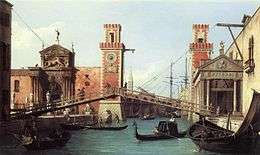
Canaletto's early works remain his most coveted and, according to many authorities, his best. One of his early pieces is The Stonemason's Yard (c. 1725, the National Gallery, London) which depicts a humble working area of the city. It is regarded one of his finest works and was presented by Sir George Beaumont in 1823 and 1828.[10]
Later Canaletto painted grand scenes of the canals of Venice and the Doge's Palace. His large-scale landscapes portrayed the city's pageantry and waning traditions, making innovative use of atmospheric effects and strong local colours. For these qualities, his works may be said to have anticipated Impressionism.
His graphic print S. A. Giustina in Prà della Vale was found in the 2012 Nazi loot discovery.[11]
Work in England
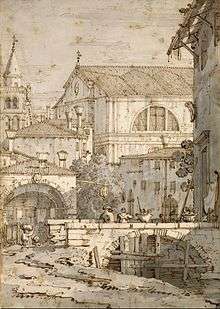
_-_Google_Art_Project.jpg)
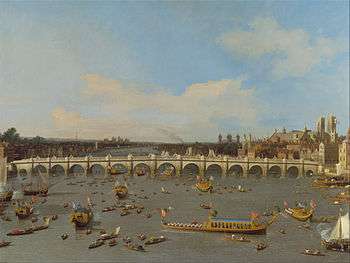

Many of his pictures were sold to Englishmen on their Grand Tour, first through the agency of Owen Swiny and later the banker Joseph Smith, appointed British Consul in Venice in 1744. It was Swiny in the late 1720s who encouraged the artist to paint small topographical views of Venice with a commercial appeal for tourists and foreign visitors to the city. Sometime before 1728, Canaletto began his association with Joseph Smith, an English businessman and collector living in Venice, who later became the artist's principal agent and patron. Smith eventually acquired nearly fifty paintings, one hundred fifty drawings, and fifteen rare etchings from Canaletto, the largest and finest single group of the artist's works, that he sold to King George III in 1763.[12]
In the 1740s Canaletto's market was disrupted when the War of the Austrian Succession led to a reduction in the number of British visitors to Venice.[13] Smith also arranged for the publication of a series of etchings of "capricci" (or architectural phantasies) (capriccio Italian for fancy) in his vedute ideale,[6] but the returns were not high enough, and in 1746 Canaletto moved to London, to be closer to his market. [5]
He remained in England until 1755, producing views of London (including several of the new Westminster Bridge, which was completed during his stay) and of his patrons' castles and houses. His 1754 painting of Old Walton Bridge includes an image of Canaletto himself.
He was often expected to paint England in the fashion with which he had painted his native city. Canaletto's painting began to suffer from repetitiveness, losing its fluidity, and becoming mechanical to the point that the English art critic George Vertue suggested that the man painting under the name 'Canaletto' was an impostor. Historian Michael Levey described his work from this period as "inhibited".[14]
The artist was compelled to give public painting demonstrations in order to refute this claim; however, his reputation never fully recovered in his lifetime.[15]
After his return to Venice, Canaletto was elected to the Venetian Academy in 1763 and appointed prior of the Collegio dei Pittori. He continued to paint until his death in 1768. In his later years he often worked from old sketches, but he sometimes produced surprising new compositions. He was willing to make subtle alternations to topography for artistic effect.[6]
Market
His pupils included his nephew Bernardo Bellotto, Francesco Guardi, Michele Marieschi, Gabriele Bella, and Giuseppe Moretti. The painter, Giuseppe Bernardino Bison was a follower of his style.[9]
Joseph Smith sold much of his collection to George III, creating the bulk of the large collection of works by Canaletto owned by the Royal Collection. in 1762, George III paid £20,000 for Consul Smith's collection of 50 paintings and 142 drawings.[16] There are many examples of his work in other British collections, including several (19) at the Wallace Collection and a set of 24 in the dining room at Woburn Abbey. A large set of Canaletto works was also part of the collection of the Earls of Carlisle, however many were lost at the 1940 fire of Castle Howard and others were sold over the last century. Among those formerly at the Carlisle collection are "The Bacino di San Marco: looking East", now at the Museum of Fine Arts, Boston (sold in 1939) and the pair "Entrance to the Grand Canal from the Molo, Venice" and "The Square of Saint Mark's, Venice", now at the National Gallery of Art, Washington DC (sold in 1938). The last important venetian veduta at Castle Howard was by Bernardo Bellotto, "A View of the Grand Canal Looking South from the Palazzo Foscari", which was sold at Sotheby's in July 2015 for £2.6 million.
Canaletto's views always fetched high prices, and as early as the 18th century Catherine the Great and other European monarchs vied for his grandest paintings. The record price paid at auction for a Canaletto is £18.6 million for View of the Grand Canal from Palazzo Balbi to the Rialto, set at Sotheby's in London in July 2005.
Works
| Painting | Title | Date | Location |
|---|---|---|---|
| Piazzetta in Venice | 1700s | Alte Pinakothek, Munich, Germany | |
| Venice: the Grand Canal | 1700s | LLL Art Galleries | |
 | Grand Canal, Looking Northeast from Palazo Balbi toward the Rialto Bridge | 1720–23 | Ca' Rezzonico, Venice, Italy |
.jpg) | San Cristoforo, San Michele and Murano from the Fondamenta Nuove, Venice | 1722–23 | Dallas Museum of Art, Dallas, Texas, United States |
| Piazza San Marco in Venice looking West with the Campanile | 1723 | House of Liechtenstein, Liechtenstein | |
 | The Piazzetta towards San Giorgio Maggiore | c. 1724 | Royal Collection, Windsor Castle, England |
| Venice: The Grand Canal, Looking North East from Palazzo Balbi to the Rialto Bridge | c. 1724 | Private collection | |
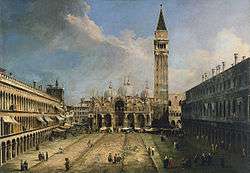 | Piazza San Marco Looking East along the Central Line | 1723–24 | Thyssen-Bornemisza Museum, Madrid, Spain |
 | Grand Canal, Looking East from the Campo San Vio | 1723–24 | Thyssen-Bornemisza Museum, Madrid, Spain |
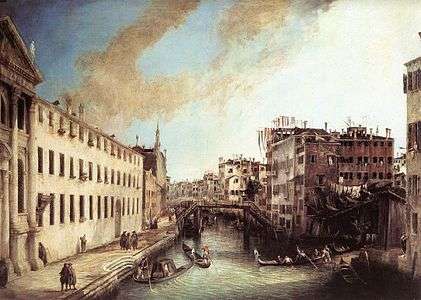 | Rio dei Mendicanti | 1723–24 | Ca' Rezzonico, Venice, Italy |
 | The Stonemason's Yard | c. 1725 | National Gallery, London, England |
 | Rio dei Mendicanti: Looking South | c. 1725 | Gemäldegalerie Alte Meister, Dresden, Germany |
 | Entrance To The Grand Canal Looking East | 1725 | Gemäldegalerie Alte Meister, Dresden, Germany |
| Doge's Palace | 1725 | ||
 | View of the Grand Canal | late 1720s | Birmingham Museum of Art, Birmingham, Alabama, United States |
 | Grand Canal: Looking from Palazzo Balbi | c. 1726 | Gemäldegalerie Alte Meister, Dresden, Germany |
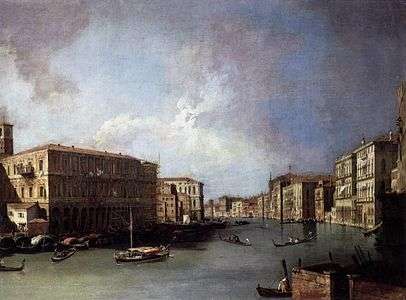 | Grand Canal: Looking North from Near the Rialto Bridge | c. 1726 | Gemäldegalerie Alte Meister, Dresden, Germany |
 | San Giacomo di Rialto | c. 1726 | Gemäldegalerie Alte Meister, Dresden, Germany |
| The Bacino di San Marco, Venice | 1725–26 | Farnborough Hall, Warwickshire | |
 | The Grand Canal near San Maria della Carità | 1726 | Pinacoteca Giovanni e Marella Agnelli, Turin, Italy |
 | Santi Giovanni e Paolo and the Scuola di San Marco | 1726 | Private collection |
| The Bacino di San Marco, Venice, Seen from the Giudecca | 1726 | Upton House, National Trust, England | |
| Venice: the Grand Canal Looking North from the Rialto | 1726–27 | Royal Collection, Windsor Castle, England | |
 | The Reception of the French Ambassador Jacques–Vincent Languet, Comte de Gergy at the Doge’s Palace, Venice | 1726–27 | Hermitage Museum, Saint Petersburg, Russia |
 | Venice: S. Geremia and the Entrance to the Cannaregio | 1726–27 | Royal Collection, Windsor Castle, England |
 | Grand Canal. The Rialto Bridge from the South | 1727 | Private collection |
 | Venice: The Grand Canal from the Palazzo Vendramin-Calergi towards S. Geremia | 1727–28 | Royal Collection, Windsor Castle, England |
| View of the Isles of San Michele, San Cristoforo and Murano from the Fondamenta Nuove | 1725–28 | Hermitage Museum, Saint Petersburg, Russia | |
 | View of Church of San Giovanni dei Battuti on the Isle of Murano | 1725–28 | Hermitage Museum, Saint Petersburg, Russia |
| A View of Dolo on the Brenta Canal | 1725–29 | Ashmolean Museum, Oxford, England | |
| The Doge's Palace, Venice | c. 1730 | Fitzwilliam Museum, Cambridge, England | |
 | The Doge's Palace and Riva degli Schiavoni, Venice | c. 1730 | Tatton Park, National Trust, England |
 | View of the Grand Canal: Santa Maria della Salute and the Dogana from Campo Santa Maria Zobenigo | c. 1730 | Fitzwilliam Museum, Cambridge, England |
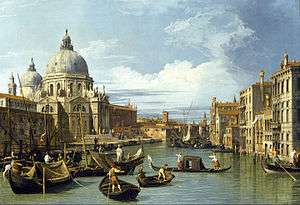 | The Entrance to the Grand Canal, Venice | c. 1730 | Museum of Fine Arts, Houston, Houston, United States |
 | The Grand Canal, Piazzetta and Dogana, Venice | c. 1730 | Tatton Park, National Trust, England |
 | Stonemason's Yard] | 1726–30 (or 1727) | National Gallery, London, England |
| Venice: the Grand Canal with S. Maria della Salute towards the Riva degli Schiavoni | 1730 | Royal Collection, Windsor Castle, England | |
| The Bacino di San Marco, Looking North | 1730 | National Museum, Cardiff, Wales | |
| S. Geremia and the Entrance to the Cannaregio | 1730 | National Gallery, London, England | |
| The Piazzetta, Venice, Looking North | 1730s | Norton Simon Museum, Pasadena, California | |
| The Molo Seen from the Bacino di San Marco | 1730s | Musée du Louvre, Paris, France | |
 | Return of the Bucintoro to the Molo on Ascension Day | 1729–1732 | Royal Collection, Windsor Castle, England |
| The Molo, Venice | c. 1735 | Kimbell Art Museum, Fort Worth, Texas, United States | |
| View of the Piazzetta San Marco Looking South | c. 1735 | Indianapolis Museum of Art, Indianapolis, Indiana, United States | |
| The Bucintoro Returning to the Molo | 1730–35 | Bowes Museum, Barnard Castle, England | |
 | Piazza San Marco, Venice | 1730–35 | Harvard Art Museums, Cambridge, United States |
| A Regatta on the Grand Canal | 1730–35 | Bowes Museum, Barnard Castle, England | |
| A View of the Rialto, Venice | 1734–35 | Sir John Soane's Museum, London, England | |
| The Piazza di San Marco, Venice | 1734–35 | Sir John Soane's Museum, London, England | |
| Venice: A Regatta on the Grand Canal | 1735 | National Gallery, London, England | |
| View of the Riva degli Schiavoni | 1736 | Sir John Soane's Museum, London, England | |
| St. Mark's and the Clock Tower, Venice | 1737 | National Gallery of Canada, Ottawa, Canada | |
 | The Grand Canal in Venice from Palazzo Flangini to Campo San Marcuola | c. 1738 | The J. Paul Getty Museum, Los Angeles |
| Santi Giovanni e Paolo and the monument to Bartolomeo Colleoni | 1735–38 | ||
| The St Mark's Square, Venice | 1738–40 | Detroit Institute of Arts, Detroit, Michigan, United States | |
 | Bacino di San Marco | 1738–40 | Museum of Fine Arts, Boston, United States |
 | Il Bucintoro al molo nel giorno dell'Ascensione | c. 1740 | Pinacoteca Giovanni e Marella Agnelli, Turin, Italy |
| Venice: The Campo SS. Giovanni e Paolo | 1740 | Royal Collection, Windsor Castle, England | |
| Venice: The Basin of San Marco on Ascension Day | 1740 | National Gallery, London, England | |
| Venice: Santa Maria della Salute | 1740 | Metropolitan Museum of Art, New York City, United States | |
| A Regatta on the Grand Canal | 1740 | National Gallery, London, England | |
| The Porta Portello, Padua | 1741–42 | National Gallery of Art, Washington D.C., United States | |
| Rome: The Arch of Constantine | 1742 | Royal Collection, Windsor Castle, England | |
| Rome: The Arch of Septimius Severus | 1742 | Royal Collection, Windsor Castle, England | |
| Rome: The Arch of Titus | 1742 | Royal Collection, Windsor Castle, England | |
| Rome: Ruins of the Forum looking towards the Capitol | 1742 | Royal Collection, Windsor Castle, England | |
| Rome: The Pantheon | 1742 | Royal Collection, Windsor Castle, England | |
| Rome: View of the Colosseum and the Arch of Constantine | 1743 | Royal Collection, Windsor Castle, England | |
| Venice: the Bacino di San Marco from San Giorgio Maggiore | 1735–44 | Wallace Collection, London, England | |
| The Square of Saint Mark's, Venice | 1742–44 | National Gallery of Art, Washington D.C., United States | |
| Entrance to the Grand Canal from the Molo, Venice | 1742–44 | National Gallery of Art, Washington D.C., United States | |
| Venice: the Molo with Santa Maria della Salute | 1740–45 | Wallace Collection, London, England | |
| Venice: the Riva degli Schiavoni | 1740–45 | Wallace Collection, London, England | |
 | Prà della Valle in Padua | 1741–46 | Museo Poldi Pezzoli, Milan, Italy |
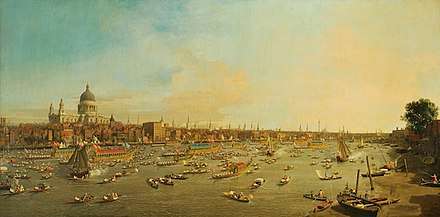 | London: The Thames on Lord Mayor's Day | 1746–47 | Lobkowicz Palace, Prague, Czech Republic |
| London seen through an arch of Westminster Bridge | 1746–47 | Syon House, London | |
| Ruins with Figures | 1747 | Fitzwilliam Museum, Cambridge, England | |
| Ruins with Figures (companion of the above) | 1747 | Fitzwilliam Museum, Cambridge, England | |
| London: River Thames looking towards Westminster from Lambeth | 1747 | Lobkowicz Palace, Prague, Czech Republic | |
| The South Façade of Warwick Castle | 1748 | Thyssen-Bornemisza Museum, Madrid, Spain | |
| Warwick Castle | 1748–49 | Yale Center for British Art, New Haven, United States | |
| The Thames at Westminster, London | 1749 | Penrhyn Castle, National Trust, Gwynedd, Wales | |
| The Bucintoro | 1745–50 | Thyssen-Bornemisza Museum, Madrid, Spain | |
| The Molo from the Basin of San Marco, Venice | 1747–50 | San Diego Museum of Art, San Diego, California[17] | |
| A View of the Molo and the Riva degli Schiavone in Venice | 1750 | Yale University Art Gallery, New Haven, United States | |
| Bacino di S. Marco: From the Piazzetta | 1750 | National Gallery of Victoria, Melbourne, Australia | |
| The Bucintoro at the Molo on Ascension Day | 1760 | Dulwich Picture Gallery, London, England | |
| View of the Grand Canal from Campo San Vio | 1740–50 | Ca' Rezzonico, Venice, Italy | |
| Venice: the Grand Canal from the Palazzo Foscari to the Carità | 1740–50 | Wallace Collection, London, England | |
| Venice: the Grand Canal from the Palazzo Dolfin-Manin to the Rialto Bridge | 1740–50 | Wallace Collection, London, England | |
| Venice: the Grand Canal from the Palazzo Flangini to San Marcuola | 1740–50 | Wallace Collection, London, England | |
| Venice: the Canale di Santa Chiara | 1740–50 | Wallace Collection, London, England | |
| The Thames from the Terrace of Somerset House, Looking toward St. Paul's | 1750 | Yale Center for British Art, New Haven, United States | |
| The Thames from the Terrace of Somerset House, Looking toward Westminster | 1750 | Yale Center for British Art, New Haven, United States | |
| London: The Thames from Somerset House Terrace towards Westminster | 1750–51 | Royal Collection, Windsor Castle, England | |
| London: The Thames from Somerset House Terrace towards the City | 1750–51 | Royal Collection, Windsor Castle, England | |
| Chelsea from the Thames at Battersea Reach | 1751 | Blickling Hall, National Trust, Norfolk, England | |
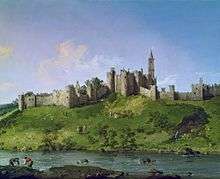 | Alnwick Castle | 1752 | Alnwick Castle, Northumberland, England |
| Greenwich Hospital from the North Bank of the Thames | c. 1752 | National Maritime Museum, Greenwich, London, England | |
| Warwick Castle, the East Front from the Outer Court | 1752 | Birmingham Museum and Art Gallery, Birmingham, England | |
| Interior of King Henry VII Chapel | 1753 | Museum of London, London, England | |
| English Landscape Capriccio with a Column | 1754 | National Gallery of Art, Washington D.C., United States | |
| English Landscape Capriccio with a Palace | 1754 | National Gallery of Art, Washington D.C., United States | |
| London: Interior of the Rotunda at Ranelagh | 1754 | National Gallery, London, England | |
| St. Paul's Cathedral | 1754 | Yale Center for British Art, New Haven, United States | |
| A View of Walton Bridge | 1754 | Dulwich Picture Gallery, London, England | |
| Eton College | 1754 | National Gallery, London, England | |
| Old Walton Bridge | 1755 | Yale Center for British Art, New Haven, United States | |
| Saint Mark's, Venice | c. 1756 | Fitzwilliam Museum, Cambridge, England | |
| Interior Court of the Doge's Palace, Venice | c. 1756 | Fitzwilliam Museum, Cambridge, England | |
| Venice: Palazzo Grimani | 1756–58 | National Gallery, London, England | |
 | Piazza San Marco Looking East from the North-West Corner | c. 1760 | National Gallery, London, England |
| Venice: the Grand Canal from Campo San Vio towards the Bacino | 1734–60 | Wallace Collection, London, England | |
| The Campo di Rialto and S. Giacomo di Rialto, Venice | 1760 | National Gallery of Canada, Ottawa, Canada | |
| Porta Portello, Padua | 1760 | Thyssen-Bornemisza Museum, Madrid, Spain | |
| Venice: the Grand Canal with Santa Maria della Salute towards the Riva degli Schiavoni | 1734–62 | Wallace Collection, London, England | |
| Venice: the Grand Canal from the Palazzo Foscari to the Carità | 1734–62 | Wallace Collection, London, England | |
| London: Northumberland House | 1753–63 | Wallace Collection, London, England | |
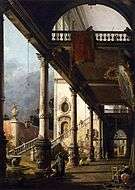 | Perspective with a Portico | 1765 | Gallerie dell'Accademia, Venice, Italy |
| Capriccio with Colonnade in the Interior of a Palace | 1765 | Thyssen-Bornemisza Museum, Madrid, Spain | |
| The School of San Marco | 1765 | Thyssen-Bornemisza Museum, Madrid, Spain |
See also
- Bernardo Bellotto, also known as "Canaletto" in Germany and Poland, was Canaletto's nephew and pupil[18]
References
- 1 2 Filippo Pedrocco (1995). Canaletto. Giunti Editore. ISBN 978-88-09-76198-8.
- 1 2 Alice Binion and Lin Barton. "Canaletto." Grove Art Online. Oxford Art Online. Oxford University Press. Web. 6 Jan. 2017
- ↑ Constable, William G. "Canaletto". Encyclopædia Britannica.
- ↑ "Canaletto", National Gallery of Art, Washington, D.C.
- 1 2 3 Haldane MacFall (20 September 2004). A History of Painting: Later Italians and Genius of Spain Part Three. Kessinger Publishing. ISBN 978-1-4179-4508-5.
- 1 2 3 Betsy Dru Tecco (30 July 2004). Pk:how to Draw Italy. PowerKids Press. ISBN 978-0-8239-6686-8.
- ↑ J.G. Links, Canaletto and his patrons, Granada Publishing/Paul Elek Ltd., London 1977, p. 1.
- ↑ Hannah Furness, 'Royal Collection uses infrared to prove Canaletto did not trace his drawings' in The Daily Telegraph (UK newspaper), 14 April 2017.
- 1 2 C. A. Fletcher; T. Spencer (14 July 2005). Flooding and Environmental Challenges for Venice and its Lagoon: State of Knowledge. Cambridge University Press. ISBN 978-0-521-84046-0.
- ↑ "Canaletto | The Stonemason's Yard | NG127 | National Gallery, London". www.nationalgallery.org.uk. Retrieved 2016-04-22.
- ↑ "Photo Gallery: Munich Nazi Art Stash Revealed". Spiegel. 17 November 2013. Retrieved 17 November 2013.
- ↑ Canaletto Venetian, 1697 - 1768 https://www.nga.gov/collection/artist-info.1080.html
- ↑ Antonio Canaletto; Antonio Visentini (1971). Views of Venice: By Canaletto. Courier Dover Publications. ISBN 978-0-486-22705-4.
- ↑ Michael Levey (1994). Painting in Eighteenth-century Venice. Yale University Press. pp. 114–5. ISBN 978-0-300-06057-7.
- ↑ John Eglin (13 January 2001). Venice Transfigured: The Myth of Venice in British Culture, 1660–1797. Palgrave Macmillan. ISBN 978-0-312-23299-3.
- ↑ Louise Jury, the Independent, 11 November, 2005
- ↑ "The Molo from the Basin of San Marco, Venice". The San Diego Museum of Art. Archived from the original on 8 January 2016. Retrieved 20 September 2014.
- ↑

External links

- Web Gallery of Art
- The Canaletto Foundation More than 335 images of Canaletto's paintings.
- Canaletto and the history of vedute
- Canaletto, a full text exhibition catalog from The Metropolitan Museum of Art